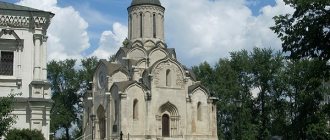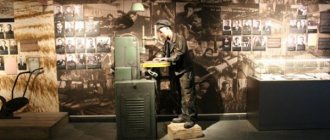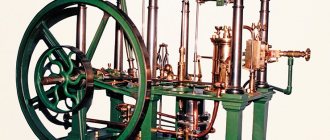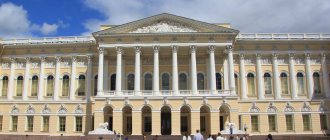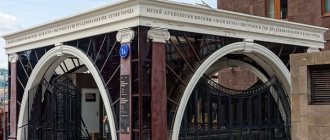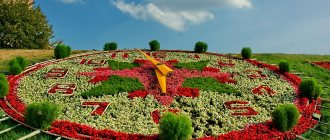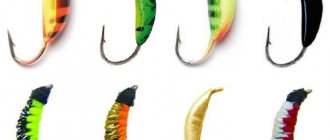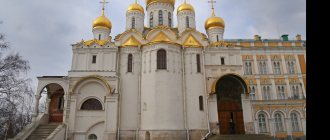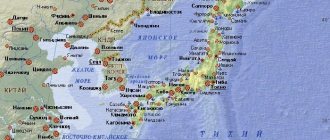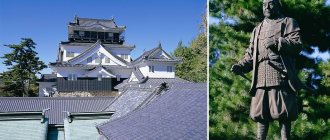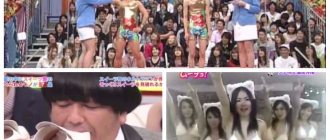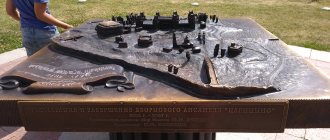In this post I will talk about five museums in Tokyo. Each of them is interesting in its own way and complements the general idea of Japan. The Tokyo National Museum introduces works of fine art. The archaeological museum amazes with magnificent fabrics that are 1300 years old. The Edo-Tokyo Museum tells in detail about the life and everyday life of the city in the last couple of centuries. The Hokusai Museum is dedicated to the work of the great master of printmaking and his followers. The Police Museum is very unusual and inspires sincere respect for law enforcement officers.
Tokyo National Museum
The National Museum is located in Ueno Park, which I mentioned in the article “Gardens and Parks of Tokyo”, not far from the pond overgrown with lotuses. You can spend a whole day in Ueno Park, visiting several museums and a zoo.
The museum's collection includes drawings, engravings, screens, scrolls, samurai armor, magnificent ancient kimonos, theatrical costumes and masks, and figurines.
A ticket costing 620 yen (390 rubles) gives you the right to visit four more museums located on the same territory as the National Museum.
Kitagawa Utamaro. Eight views of the Tama River. Tama River in Koya
Utagawa Kiniyoshi. 33 types of Fuji. Mount Fuji on a clear day from the Tsukudajima coast
Utagawa Hiroshige. Famous places in six provinces. Snowy Mountain Haruna, Kozuke Province.
Tokyo
Fuji Art Museum
16
Tokyo, Japan
Bridgestone Museum of Art
4
Bridgestone Museum of Art, 1 Chome-1-10-1 Kyōbashi, Chūō-ku, Tōkyō-to 104-0031, Japan
National Museum of Western Art
11
National Museum of Western Art, 7-7 Uenokōen, Taitō-ku, Tōkyō-to 110-0007, Japan
Seiji Togo Memorial Sompo Japan Museum of Art
1
Sompo Japan Bldg, Seiji Togo Memorial Yasuda Kasai Museum of Art, 1 Chome-26-1 Nishishinjuku, Shinjuku-ku, Tōkyō-to 160-0023, Japan
Archaeological Museum
While we were exploring the National Museum, it started pouring rain outside (a typhoon was passing over Japan that day). We decided to wait out the bad weather and headed to the Archaeological Museum, since the purchased ticket gave us the right to examine it too.
The archaeological museum is quite small. The lower floor displays a huge number of almost identical Buddhist figurines, which did not interest me. But the exhibits on the second floor shocked us with their antiquity. These are pieces of wood, seals and fabric from the 7th-8th centuries.
What struck me most was this fabric, which dates back to the eighth century. In its appearance and ornament, it resembled church brocade - grape bunches and leaves, and even traceable crosses, a golden hue.
In Russia this is a pagan, pre-Christian time; in Byzantium - flourishing. Byzantine fabrics of this time might well have looked like this. It is extremely difficult to assume contacts between Byzantium and Japan in the 8th century, all the more shocking is the flow of artistic ideas across seas and continents.
Edo-Tokyo Museum
I have already shown photographs from this museum several times in other posts: about waste sorting, about the Kabuki theater, about seismic stability. The Edo-Tokyo Museum greatly expanded my knowledge of Japan.
The museum building itself is noteworthy. It resembles a turtle, or a tank, or maybe a sumo wrestler, heavy but stable. The ticket is purchased below, and then you can take the escalator up to the museum halls.
I was asked to take part in a survey of visitors - they are interested in the geography of their visitors and the effectiveness of advertising.
At the Edo-Tokyo Museum, I came across a volunteer guide service that I had read about before the trip. This system employs mainly Japanese pensioners who receive a good pension and do not need money, but experience a lack of communication. Therefore, they conduct free tours for tourists in different languages.
I was interested in trying to use this service. At the volunteer guide stand there was a sign with a list of available languages; at the moment only English was offered. This is exactly what I needed. An elderly Japanese woman, bored behind the reception girls, stood up to meet me with a sincere smile. She introduced herself as Akiko. It was easy for me to remember this name because it was the name of the main character of the film that I watched on the plane.
Akiko was very petite, only reaching my shoulder height. She asked how much time I had (plenty) and said that a leisurely tour of the museum would take about two hours. That's pretty much what happened. She spoke fluently in English about the exhibition, but she had difficulty understanding my questions (when I wanted to clarify details or go deeper into details). Overall it was an interesting experience and I was glad I decided to do it.
The museum's exposition is dedicated to the development of the Japanese capital. In the first period of its development, the city was called Edo, this was the time of feudal Japan. In 1856, after the end of Japan's self-isolation, the European path of development began. The second part of the museum, which bears the double name of Edo-Tokyo, is dedicated to him.
Maps, diagrams, layouts, photographs, full-size models of buildings and interiors, household items, ancient engravings - all this is accompanied by detailed texts in Japanese and English. There are interactive elements: you can climb into a palanquin, try to lift a heavy beam with baskets of fish, take a photo on the tatami in a traditional Japanese house.
The entrance fee is modest: 600 yen (375 rubles).
Traditional Japanese float for festival processions
Model of the movement of festival carts. Japan is very fond of such festivals; festival processions are held in every city 1-2 times a year. The carts are different everywhere, they are stored in special buildings (sometimes with access for tourists, more often without), and everywhere they have their own ritual significance.
Fishmonger's baskets. You can try to lift
Portable stand of a cooked rice vendor. This building is very heavy
Traditional Japanese house where you can sit on tatami
Ornaments on fabrics of the Edo period. They look quite modern
Books were in great demand during the Edo period. Bookstores sold color pictures—prints of engravings of famous actors, courtesans, and sumo wrestlers. The landscape genre arose a little later and also gained great popularity.
In addition, books with black and white illustrations were sold. Many books had sharply satirical and political content, which the people really liked, but the rulers did not really like. Therefore, booksellers preferred to hide their faces under wicker basket-like hats to avoid being caught by the authorities.
Hokusai Museum
Katsushika Hokusai is perhaps the most famous and one of the most prolific printmakers of the Edo period. No wonder there is a separate Hokusai Museum in Tokyo, located a five-minute walk from the Edo-Tokyo Museum.
This is a modern building with bold architecture. Hokusai's most famous work, Red Fuji, greets you right on the pavement.
I went to this museum in the hope of finally seeing all 36 famous views of Fuji - the master’s program series, presented in one room. Well, at least 18! But alas. Even in this highly specialized museum of Hokusai prints there are hardly three dozen, from different series. Not a single series is presented in its entirety, even in reproductions.
Location map of "36 Views of Mount Fuji" displayed at the Edo-Tokyo Museum
The ticket is quite expensive - 1200 yen, twice as expensive as previous museums. True, you can visit only the main exhibition for less money, but this is only one small hall.
The main exhibition tells about the creative path of the master. Several of his early works are presented. But the most interesting thing is the step-by-step process of making the engraving. The photos below were taken at the Edo-Tokyo Museum; The Hokusai Museum similarly shows the process of working on another famous print.
To obtain a sheet of engraving, several wooden boards are made according to the sketch to create a relief image of different parts of the drawing. Separate boards are cut for each color.
The next step is applying paint to the board. If the artist wants to achieve a blur effect from dark to light, he applies the paint accordingly.
Next, impressions are made one after another. Accurate alignment with each print is very important: even a 1 mm offset will result in a blurred image.
This is what the sheet looks like after each subsequent print.
The wax figures of Hokusai and his sister were made so realistically that I watched my hand for a minute, expecting it to tremble. Katsushika Hokusai is depicted at a very old age, but still at work. In the back of the room there are crumpled sketches: the master was very critical of his work.
In addition to the main exhibition, there are temporary ones. I found an exhibition dedicated to bridges. A thematic selection of prints by Japanese artists from the Edo period showed the variety of bridge designs.
One of the engravings was called “One Hundred Bridges from One Point.” I was not lazy and counted them all. On a fantasy landscape in A3 format (about 30x40 cm), I managed to count 96 large and small bridges (but perhaps I got lost, and there are really 100 of them).
On another floor, the exhibition continued with photographs and drawings of various bridges built in the 20th century. Unfortunately, photography is not allowed at the temporary exhibition.
Museums of Japan
The Land of the Rising Sun has a rich history, an unusual culture, and is also famous for its innovative developments, of which the Japanese are very proud. Local residents open and create all kinds of museums where travelers can find out information that interests them.
What museums are there in Tokyo?
The capital contains various valuable exhibits and artifacts. They introduce tourists to the life of the population, its traditions and history. The most popular among them are:
- National Museum.
The largest and oldest in the country. It consists of 5 buildings and has a total area of 100 thousand square meters. m. More than 120,000 exhibits made of ceramics, metal, porcelain, as well as exhibits of weapons, armor, fabrics, etc. are stored here. - Museum of Money.
It was founded in honor of the 100th anniversary of the Bank of Japan in 1982. The institution is engaged in educational work, research and collection of samples of banknotes and coins from all over the planet. - Museum of Records.
It is dedicated to the Guinness Book and introduces visitors to incredible human achievements. There are wax figures, newspaper extracts, and stands with photographs of historical figures. - Ghibli Museum in Japan.
Founded by Hayao Miyazaki in 2001. The exhibitions are dedicated to animated films and the history of their creation. The building itself is also considered an exhibit. - Museum of Western Art.
It houses a diverse private collection of sculptures and paintings by businessman and politician Matsukata Kozdiro. He collected works of art throughout Europe. - Museum of Contemporary Art
in Japan. It is also called MOMAT and was opened in 1952. It includes a cinema center, a crafts gallery, and an art library. - National Science Museum
of Japan in Tokyo. Here you can see various exhibitions of natural origin and the history of the development of world technology: from a stone ax to modern electrical appliances.
Museums in the cities of Hiroshima and Nagasaki
In these world-famous settlements there are museums dedicated to the nuclear bombing, when a huge number of local residents died. These cities are worth visiting:
- Peace Memorial Museum
in Japan. Here are 2 models showing visitors the area before and after the attack, photographs showing wounded people, as well as household items damaged by the explosion. - Atomic Bomb Museum in Nagasaki,
Japan. Its main exhibit is a model of the atomic bomb that instantly killed more than 74,000 people on August 9, 1945, and also irradiated several thousand residents who died later. The building was built at the epicenter of the explosion. - Literary Museum.
It is dedicated to the work and life of the Japanese writer Shusaku Endo, who was nominated for the Nobel Prize several times. - Museum of Culture and History.
It houses 48 thousand exhibits, consisting of works of decorative and applied art and Christian objects that were brought from China, Korea and Holland. - Transport Museum.
It opened in 1995 and introduces visitors to local means of transportation.
Other famous museums in Japan
There are a large number of important and interesting establishments located in various cities of the country, the most popular of which are:
- Toyota Museum in Japan.
The exhibition hall is called Kaikan Exhibition Hall, it introduces visitors to new products in the automotive industry and the history of manufacturing. Here you can see 150 cars of American, European and local production. - Yusukan Museum.
Tells his guests about the military history of the state. It is located in the Chieda area, near Yasukuni Shrine. - Museum in Kobe.
It was founded in 1982 and is supported by the city. Archaeological exhibits and art objects of the “southern barbarians” are stored here. - Museum in Fukuoka.
Located in the coastal area. The exhibits are stored in three halls, in two of them a new thematic exhibition opens every season, and in the third there is a historical and cultural exhibition about the city. - Art Museum in Kitakyushu.
Here you can see about 6 thousand works of art. The institution hosts various exhibitions throughout the year. - Children's Museum.
It introduces its visitors to the basics of astronomy with the help of a modern projector and films. This is a 4-story building with a library, halls and a planetarium. - Maritime Museum.
It has a spherical shape, silver color and consists of 4 floors. A replica of the merchant ship Nanivamaru and household items are kept here. - The Miraikan (Robot) Museum
in Japan or the Museum of Innovation and Science. This is an establishment where you can see the advanced developments of scientists, touch interactive models with your hands, or communicate with robots.
What unusual museums are there in Japan?
In the Land of the Rising Sun, original establishments were opened that amaze with their exhibits. Worth to visit:
- The Snowflake Museum
in Japan, also known as the Snow and Ice Museum. It was founded by the scientist Nakaya Ukichiro in the city of Kaga. Here you can see a wide variety of photographs of snowflakes. - Beer Museum.
It is dedicated to brewing, admission is free, and visitors are offered not only to get acquainted with the history of development and production, but also to taste the drink. - Museum of the Little Prince in Japan.
The exhibits of the institution tell about the life of the author of the famous book with the help of photographs and letters. There is also a small theater here, where actors introduce the life of the main character. - Noodle Museum in Japan.
Visitors will be able to get acquainted with the history of the creation of ramen and special dishes for it, with cooking recipes, as well as taste the most popular noodle dishes. - Poop Museum in Japan.
An unusual place where you can see models of human and animal excrement, sculpt them out of clay yourself, and ride on a toilet-shaped slide. - Temari Museum in Japan.
It is dedicated to an amazing and very beautiful type of needlework. There are training schools here, where students are awarded a certain degree at the end of the course. - Fruit Museum in Japan.
Exhibition halls occupy underground and above-ground premises. The buildings look like nutshells - a symbol of seeds that were thrown into fertile soil. - International Manga Museum in Japan.
It is dedicated to the famous character from the anime series - the blue robot cat named Doraemon. - The Meguro Museum of Parasitology
in Japan, which displays photographs, models and embalmed animals with worms and worms. The most popular exhibit is a brain infested with parasites.
